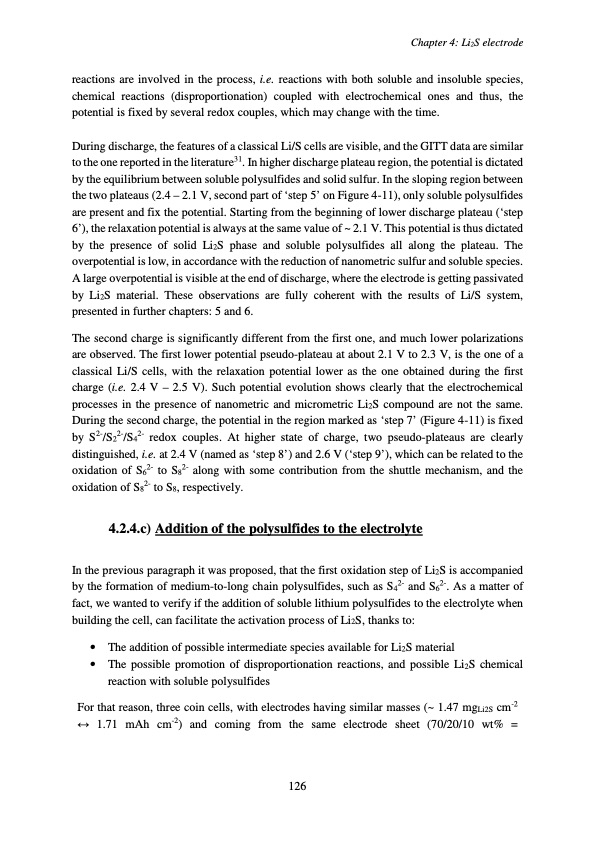
PDF Publication Title:
Text from PDF Page: 130
reactions are involved in the process, i.e. reactions with both soluble and insoluble species, chemical reactions (disproportionation) coupled with electrochemical ones and thus, the potential is fixed by several redox couples, which may change with the time. During discharge, the features of a classical Li/S cells are visible, and the GITT data are similar to the one reported in the literature31. In higher discharge plateau region, the potential is dictated by the equilibrium between soluble polysulfides and solid sulfur. In the sloping region between the two plateaus (2.4 – 2.1 V, second part of ‘step 5’ on Figure 4-11), only soluble polysulfides are present and fix the potential. Starting from the beginning of lower discharge plateau (‘step 6’), the relaxation potential is always at the same value of ~ 2.1 V. This potential is thus dictated by the presence of solid Li2S phase and soluble polysulfides all along the plateau. The overpotential is low, in accordance with the reduction of nanometric sulfur and soluble species. A large overpotential is visible at the end of discharge, where the electrode is getting passivated by Li2S material. These observations are fully coherent with the results of Li/S system, presented in further chapters: 5 and 6. The second charge is significantly different from the first one, and much lower polarizations are observed. The first lower potential pseudo-plateau at about 2.1 V to 2.3 V, is the one of a classical Li/S cells, with the relaxation potential lower as the one obtained during the first charge (i.e. 2.4 V – 2.5 V). Such potential evolution shows clearly that the electrochemical processes in the presence of nanometric and micrometric Li2S compound are not the same. During the second charge, the potential in the region marked as ‘step 7’ (Figure 4-11) is fixed by S2-/S22-/S42- redox couples. At higher state of charge, two pseudo-plateaus are clearly distinguished, i.e. at 2.4 V (named as ‘step 8’) and 2.6 V (‘step 9’), which can be related to the oxidation of S62- to S82- along with some contribution from the shuttle mechanism, and the oxidation of S82- to S8, respectively. 4.2.4.c) Addition of the polysulfides to the electrolyte In the previous paragraph it was proposed, that the first oxidation step of Li2S is accompanied by the formation of medium-to-long chain polysulfides, such as S42- and S62-. As a matter of fact, we wanted to verify if the addition of soluble lithium polysulfides to the electrolyte when building the cell, can facilitate the activation process of Li2S, thanks to: • The addition of possible intermediate species available for Li2S material • The possible promotion of disproportionation reactions, and possible Li2S chemical reaction with soluble polysulfides For that reason, three coin cells, with electrodes having similar masses (~ 1.47 mgLi2S cm-2 ↔ 1.71 mAh cm-2) and coming from the same electrode sheet (70/20/10 wt% = Chapter 4: Li2S electrode 126PDF Image | Accumulateur Lithium Soufre

PDF Search Title:
Accumulateur Lithium SoufreOriginal File Name Searched:
WALUS_2015_archivage.pdfDIY PDF Search: Google It | Yahoo | Bing
Sulfur Deposition on Carbon Nanofibers using Supercritical CO2 Sulfur Deposition on Carbon Nanofibers using Supercritical CO2. Gamma sulfur also known as mother of pearl sulfur and nacreous sulfur... More Info
CO2 Organic Rankine Cycle Experimenter Platform The supercritical CO2 phase change system is both a heat pump and organic rankine cycle which can be used for those purposes and as a supercritical extractor for advanced subcritical and supercritical extraction technology. Uses include producing nanoparticles, precious metal CO2 extraction, lithium battery recycling, and other applications... More Info
| CONTACT TEL: 608-238-6001 Email: greg@infinityturbine.com | RSS | AMP |